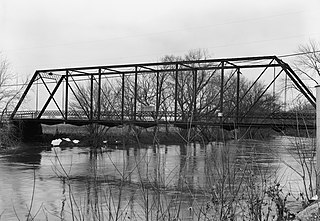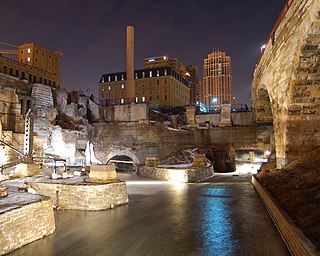
Fulton is a city in the western part of Oswego County, New York, United States. The population was 11,389 as of the 2020 census. The city is named after Robert Fulton, the inventor of the steamboat.
The Illinois Historic Preservation Division, formerly Illinois Historic Preservation Agency, is a governmental agency of the U.S. state of Illinois, and is a division of the Illinois Department of Natural Resources. It is tasked with the duty of maintaining State-owned historic sites, and maximizing their educational and recreational value to visitors or on-line users. In addition, it manages the process for applications within the state for additions to the National Register of Historic Places and other federal preservation schemes.

U.S. Route 66 was a United States Numbered Highway in Illinois that connected St. Louis, Missouri, and Chicago, Illinois. The historic Route 66, the Mother Road or Main Street of America, took long distance automobile travelers from Chicago to Southern California. The highway had previously been Illinois Route 4 and the road has now been largely replaced with Interstate 55 (I-55). Parts of the road still carry traffic and six separate portions of the roadbed have been listed on the National Register of Historic Places.

The Babylon Bend Bridge is one of nine metal highway bridges in Fulton County, Illinois listed on the National Register of Historic Places and still standing. This bridge was built in 1890 over the Spoon River and is located along Illinois Route 123 near Ellisville. It was added to the National Register of Historic Places on October 29, 1980, along with the eight other bridges, as one of the "Metal Highway Bridges of Fulton County. Some of the other bridges included the now demolished Duncan Mills Bridge in Lewistown and the Indian Ford Bridge in London Mills, Illinois. In total, six of the nine bridges have been destroyed.

The Indian Ford Bridge was one of nine metal highway bridges in Fulton County, Illinois listed on the National Register of Historic Places. This particular one was located along County Highway 20 as spans the Spoon River, 1.5 miles (2.4 km) southwest of London Mills. It was added to the National Register of Historic Places on October 29, 1980, along with the eight other bridges, as one of the "Metal Highway Bridges of Fulton County." Some of the other bridges included London Mill's only other Registered Historic Place, the now demolished London Mills Bridge. Other demolished bridges include the Elrod Bridge, Duncan Mills Bridge and Buckeye Bridge.

The London Mills Bridge was one of nine metal highway bridges in Fulton County, Illinois listed on the National Register of Historic Places. This particular one was located along County Highway 39 as it spans the Spoon River on the north side of London Mills. It was added to the National Register of Historic Places on October 29, 1980, along with the eight other bridges, as one of the "Metal Highway Bridges of Fulton County". Some of the other bridges included London Mill's only other Registered Historic Place, the Indian Ford Bridge.

The Seville Bridge is one of nine metal highway bridges in Fulton County, Illinois that were listed on the National Register of Historic Places. This particular one is located across the Spoon River in Seville. It was added to the National Register of Historic Places on October 29, 1980, along with the eight other bridges, as one of the "Metal Highway Bridges of Fulton County. Some of the other bridges include the Buckeye Bridge, Tartar's Ferry Bridge and the Bernadotte Bridge, all in Smithfield. Five of the nine bridges have been demolished, though Seville Bridge still stands.

The Bernadotte Bridge at Bernadotte, built in 1910, is one of nine metal highway bridges in Fulton County, Illinois listed on the National Register of Historic Places. The bridge is located along County Route 2 between Smithfield, Illinois to the north, and Ipava, Illinois to the south. It was added to the National Register of Historic Places on October 29, 1980, along with the eight other bridges, as one of the "Metal Highway Bridges of Fulton County". The bridge is one of three near Smithfield listed on the Register, the others are the Buckeye Bridge and the Tartar's Ferry Bridge. A fourth bridge near the Smithfield was included on the Register but removed in 1996, following its 1995 destruction.

Buckeye Bridge also known as White's Ferry Bridge was one of nine metal highway bridges in Fulton County, Illinois once listed on the National Register of Historic Places. Buckeye is one of the five bridges that have been demolished out of nine similar bridges in the county. This particular one was over the Spoon River near Smithfield, Illinois. It was added to the National Register of Historic Places on October 29, 1980, along with the eight other bridges, as one of the "Metal Highway Bridges of Fulton County". The bridge was one of three near Smithfield listed on the Register, the others are the Bernadotte Bridge and the Tartar's Ferry Bridge. Others, such as the Babylon Bend Bridge in Ellisville, are located throughout the county. Another Smithfield area bridge, Elrod Bridge, was nominated with the original Multiple Property Submission but removed from the Register after its 1995 destruction by an F-4 tornado.

Tarter's Ferry Bridge was one of nine metal highway bridges in Fulton County, Illinois listed on the National Register of Historic Places. This particular one was a 9-panel Parker through truss that carried Tarter Ferry Road over the Spoon River near Smithfield, Illinois. It was added to the National Register of Historic Places on October 29, 1980, along with the eight other bridges, as one of the "Metal Highway Bridges of Fulton County. The bridge was one of three in Smithfield listed on the Register, the others are the Bernadotte Bridge and the destroyed Buckeye Bridge, as well as the demolished Elrod Bridge. Others, such as the Duncan Mills Bridge in Lewistown, are located throughout the county.

The Metal Highway Bridges of Fulton County Thematic Resources is the title for a Multiple Property Submission to the National Register of Historic Places in the U.S. state of Illinois. Originally the submission included nine separate bridges throughout Fulton County; however, since the Metal Highway Bridges' inclusion on the Register in 1980, more than half of those bridges have been destroyed.
Elrod Bridge was one of nine metal highway bridges in Fulton County, Illinois once listed on the National Register of Historic Places. It was listed from 1980 until 1995.

Mill Ruins Park is a park in downtown Minneapolis, Minnesota, United States, standing on the west side of Saint Anthony Falls on the Mississippi River and running from 3rd Ave. S. to about 9th Ave. S. The park interprets the history of flour milling in Minneapolis and shows the ruins of several flour mills that were abandoned.

The Lyndon Bridge is a metal Parker Pratt through truss bridge in the village of Lyndon, Whiteside County, Illinois, United States. The Lyndon Bridge was designed by engineer R.S. Riser and completed in 1894 for around $20,000. Whiteside County maintained the bridge from its construction until it was closed to all traffic in 1980. In 1995, as the county was about to demolish the bridge, a group of citizens worked together and saved it from demolition. The bridge was listed on the U.S. National Register of Historic Places in 2003.

Millville is a defunct settlement in Jo Daviess County, Illinois, United States, located within the boundaries of Apple River Canyon State Park. Founded in 1835 and platted in 1846, the community was washed away completely by a flood in 1892. No visible remnants of its structures remain today. The site of Millville was added to the U.S. National Register of Historic Places as the Millville Town Site in 2003.

The Moritz Bergstein Shoddy Mill and Warehouse are two historic industrial buildings in Stillwater, Minnesota, United States, in which Jewish German immigrant Moritz Bergstein conducted a recycling business circa 1890 to 1910 providing materials for mattresses. They were originally built in Oak Park Heights, Minnesota, around 1890 and were moved to neighboring Stillwater in 2012 to make way for construction of the St. Croix Crossing bridge. The property was listed on the National Register of Historic Places in 2008 for its local significance in the themes of industry and social history. It was nominated as a rare surviving embodiment of Minnesota's early Jewish immigrants and their frequent participation in the waste materials trade.
The Illinois Steel Bridge Company was an American manufacturer of bridges based in Jacksonville, Illinois. It is credited as builder of a number of bridges and other structures that are listed on the National Register of Historic Places.

The Martin's Mill Covered Bridge is a wooden covered bridge spanning Lull's Brook on Martinsville Road in Hartland, Vermont. Built about 1880, it is one of two surviving 19th-century covered bridges in the town. It was listed on the National Register of Historic Places in 1973.

The Mill Covered Bridge is a replica historic covered bridge carrying Spring Road across the First Branch White River in Tunbridge, Vermont. It was built in 2000, nearly replicating a previous structure built on the site in 1883 and lost due to ice damage. It is one of a high concentration of covered bridges in Tunbridge and Chelsea. The 1883 bridge was listed on the National Register of Historic Places in 1974.

The Columbia Historic District is a neighborhood in Cedarburg, Wisconsin, that is listed on the National Register of Historic Places. At the time the district was listed on the register, its contributing properties included 128 historic homes, one church, and eighty-seven historic outbuildings, including garages and barns, all constructed between 1844 and 1938. The district also contained several dozen buildings that do not contribute to the historic district, including modern homes from the post-war era as well as modern garages and other additions to historic properties.

















